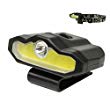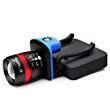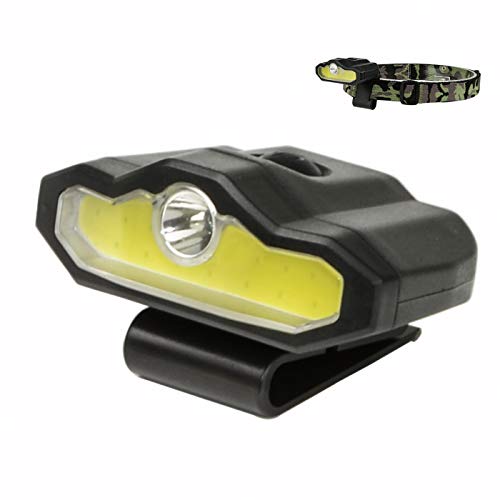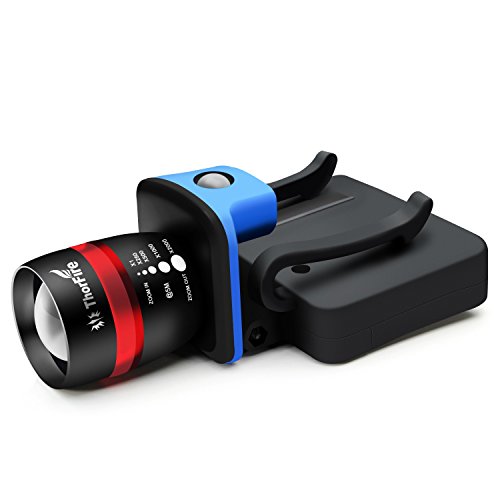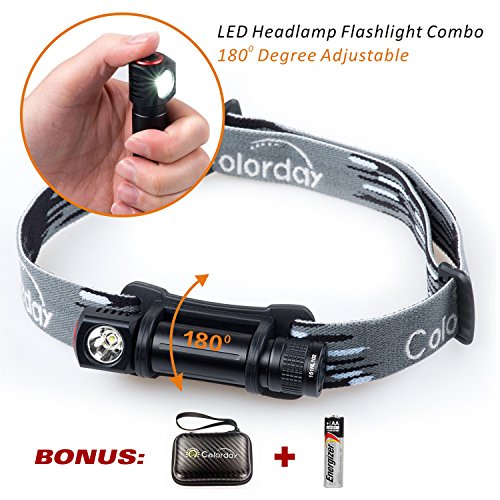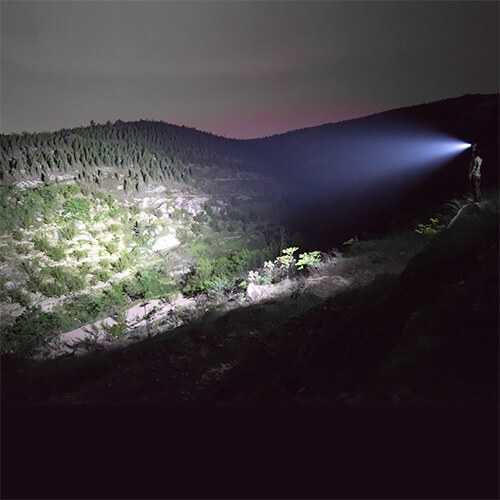
Sure, headlamps have become wildly popular in recent years — but flashlights still have their place on the trial and for good reasons.
This article will explore why flashlights are a great choice for some backpackers as well as what makes the best backpacking flashlights.
More...
There are several features I consider absolutely necessary in a backpacking flashlight:
Let’s take a deep dive into the criteria of backpacking flashlights and how to choose your next backpacking flashlight.
Comparison Chart
Name | Price | Weight | Rating | Lumens |
|---|---|---|---|---|
$$$ | 1 lb | 155 lumens | ||
$$$ | 1.87 oz | 900 lumens | ||
$$$ | 5.6 oz | 216 lumens | ||
$$$ | 2.2 oz | 300 lumens | ||
$$$ | 0.3 oz | 155 lumens | ||
$$$ | 1.28 oz | 150 lumens | ||
$$$ | 4 oz | 325 lumens | ||
$$$ | 6.2 oz | 900 lumens | ||
$$$ | 6.2 oz | 900 lumens | ||
$$$ | 3.36 oz | 350 lumens | ||
$$$ | 8 oz | 700 lumens | ||
$$$ | 2.4 oz | 85 lumens | ||
$$$ | 3.7 oz | 100 lumens |
How to Choose the Best Backpacking Flashlight for You
Battery Life
Today we have tons of options for batteries in flashlights, including replaceable batteries:
Let’s look at the pros and cons of each battery type…
Disposable Alkaline
Rechargeable Alkaline
Lithium
NiMH
Overall, the best battery choice for backpacking is probably Lithium for single users or NiMH if you want to recharge your batteries.
A Word About Recharging
When it comes to lightweight and ultralight backpacking the debate rages on between disposable and rechargeable batteries. Which is lighter? Is one or the other better in all situations?
Today we have such good portable battery packs that are so darn cheap that recharging in the field is more feasible than it was even 5 years ago. To really find out if rechargeable or disposable batteries are more efficient it requires a lot of math and testing with each headlamp and battery pack.
In general, I would say that rechargeable batteries on a headlamp are about as good, all things considered, as disposable batteries for lightweight backpacking. Now, that falls apart if you try to use something like a solar panel to recharge with. Solar panels are still too heavy, bulky, and inefficient to qualify for lightweight backpackers.
I’d advise that you stick with a quality headlamp with a good rechargeable battery and a decent 10,000 mAh battery pack (or less, depending) and you’ll be all good. If you’re a real gram weenie, a headlamp powered by 3 AAA batteries with 3 extra in your backpack for backup will probably be the lightest absolute option in most situations.
Of course, an added benefit of recharging is that you save those disposable batteries from going to the landfill so if that’s important to you, get after it!
Waterproof Ratings
Because we’ll be using our flashlights in harsh conditions, we’ll need to keep them safe from the elements. Maybe the most well-known waterproof rating system is the international protection rating, or IPX.
This system uses a single-digit scale for describing the “proofness” of flashlights, so let’s take a look at how they work.
Let’s consider the following rating: IPX6
By using a standard chart for IPX ratings, we can determine that the number (6) means the flashlight is protected from “powerful water jets”. Each rating has a test providing exact specifications on how the test must be performed and how long the flashlight must be subjected to the test.
Generally, a rating of IPX6 or better should be just fine for backpacking uses!
Lightweight
This is always a consideration when we’re picking backpacking gear. It’s important to reduce weight wherever we can when we’re considering our backpacking gear since these objects have to be carried on your back all day!
There are a few considerations, however, that may factor in to our choice. While plastic may be lighter than metal in most cases, metal is usually more durable. For some this trade-off may be worth the weight.
Weight is always relative, as well. Each hiker has their own priorities and we all need to consider what’s the most important feature in a backpacking flashlight. Perhaps you’re willing to carry more weight in order to have a brighter or more durable flashlight.
Just remember, all things being equal, we always want to opt for the lighter weight backpacking choice so long as that choice doesn’t compromise performance.
Light Output
Flashlights have one job: create light. Ideally, the best backpacking flashlights are going to put out a high amount of light in a small, lightweight form factor. But how is light output measured?
Lumens
This is a measurement of the total amount of light created by a flashlight. While there are different ways to measure lumens, we’ll consider any lumen measurement to be adequate for comparison.
Lux, Candela, Throw
These are all ways of measuring light output in various forms. It’s very rare for manufacturers to note these specifications so we’ll consider them moot points for choosing the best backpacking flashlights.
Headlamps vs Flashlights
Okay, so the line blurs when you start getting into things like hat clip lights, removable lights, and other mash-up style flashlights. Let’s go over the basics just to clear the air.
Headlamps for our purposes are attached to a strap that goes around the head. They’re great for hands-free operation and I personally love these for backpacking since my hands are usually free cooking, carrying hiking poles, or tying off tarp straps.
Flashlights are usually free-standing units that throw a beam of light. On our list, flashlights may have hat clips, chest clips, or even removable headbands so they can function as headlamps.
It’s not worth battling about the semantics, but suffice it to say that we’ve tried to focus on flashlights and hybrids for this article rather than dedicated headlamps.
For backpacking, I think you need some way of making your light hands free. Whether that’s a hat clip, a removable headband, or another hands-free method it doesn’t matter. Just remember for all you flashlight lovers, it’s a real pain in the butt to try cooking dinner, pitching a tent, and putting out your sleeping pad when one of your hands is full with a flashlight or you’re trying to hold it between your teeth.
There are some situations, however, where many people just prefer having a flashlight in their hands. That’s where a hybrid style light comes in handy such as a lightweight flashlight with a reversible hat clip. We’ll cover all that soon!
Best Backpacking Flashlights
1) Fenix MC11 – Best Overall Backpacking Flashlight
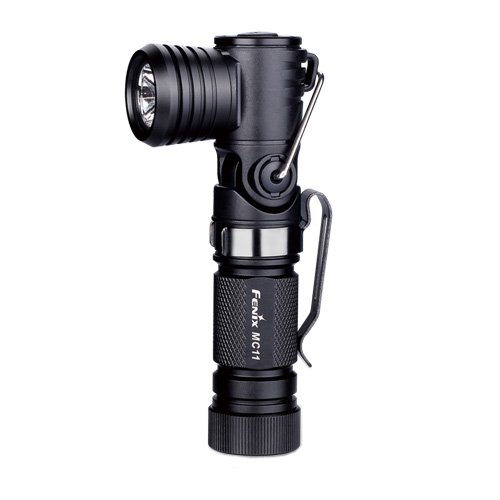
With just one AA battery, this light puts out up to 105 lumens for over an hour. Conveniently, however, there are three different settings to choose from for varying output and battery life combinations.
Why did this flashlight make the list over everything else on the market? Because it’s reasonably light, adjustable, and can be clipped to the shoulder strap (or hat brim) for night hiking just like a headlamp. You can even set it on the picnic table or hang it in the tent for light all the time.
Here’s all the things I love about the Fenix MC11:
- Fenix brand is reliable and proven with a lifetime guarantee!
- Light can be used as an angled flashlight or straight flashlight
- Pocket clip and be used to attach to the pack or hat
- Only 2.3oz overall weight
- Can run up to 100 hours on a single AA battery
In one simple package, this flashlight manages to cover so many of the essential needs of hikers, it’s hard to say “no”. Adjust the head to be inline with the handle and you’ve got a traditional flashlight or a hat brim light that can replace a headlamp. Angle the light at a 90 degree bend and you can carry the light on your backpack shoulder strap – essentially the same function as a headlamp. It even weighs less than most conventional headlamps.
Possibly the most useful feature of the Fenix? The stated 100-hour run-time on a single AA battery. This is great because specialty batteries can be difficult to come by in many locations and having three power saving modes means you can adjust your battery use to fit your needs at all times.
2) Nitecore EA11 – Most Tech-Savvy Backpacking Flashlight
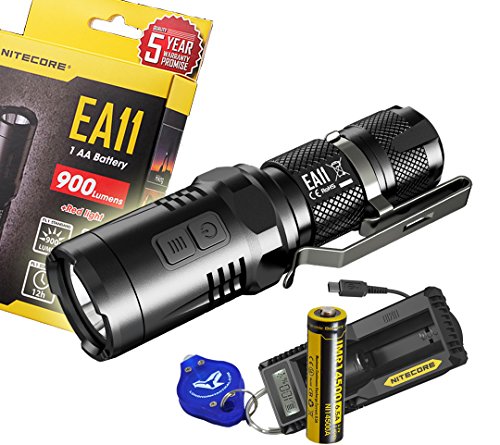
This might be the most impressive technical light in our review lineup today.
Nitecore makes some really great gear and they have an established name in the tactical light industry – from military to law enforcement. This small form factor light operates off of one AA battery (or one IMR 14500 battery) and can produce up to 900 lumens for 30 minutes at a distance of over 620 feet.
Now, keep in mind that you’ll have to use the upgraded IMR battery to achieve these high statistics, but they’re rechargeable and if you run out, you can easily replace them with standard AA batteries which will achieve 160 lumens for 45 minutes at the highest output in this light.
I love this light because it weighs in at just 1.87 ounces according to Nitecore and has so many flexible output options! In rare cases, you might need a high lumen output for search and rescue or other emergencies. Most of the time, however, the moderate 40 lumen mode (with AA’s) will last you nearly 3 hours of use. Considering that my current headlamp operates off of 4 x AAA batteries, this light is more weight conscious right out of the gate.
The Nitecore EA11 also includes a reversible pocket clip so you can carry the light in your pocket for work, or flip the clip around and use it as a headlamp replacement hat clip on the trail.
These are some of the reasons I would consider the EA11 as my backpacking flashlight:
- Uses one easy to find AA battery
- Adjustable and reversible pocket clip
- Lightweight construction at just 1.87 ounces
- Many output modes
- IPX8 waterproof, submersible rated
One of the biggest drawbacks of the EA11, however, is the short battery lifespan. A single AA battery will last just 10 hours at most on 1 lumen output mode. That’s not enough light to perform normal tasks, only enough for a serious emergency when you’ve totally run out of batteries. Compared to many backpacking headlamps, this short lifespan is quickly out-performed. However, when we take into account that most headlamps require several batteries (my Black Diamond headlamp takes 4), the operational time at a more reasonable 40 lumens becomes 11 hours when adjusted.
3) Foursevens Mini M2A – Simple and Light Backpacking Flashlight
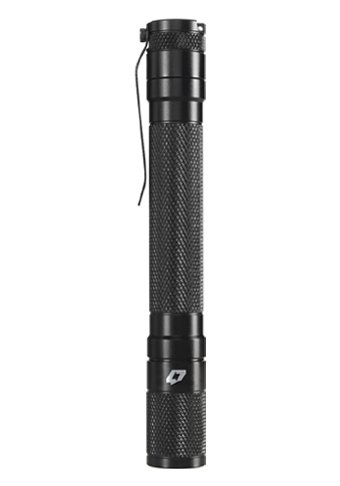
This flashlight manufacturer produces reliable and rugged light from Georgia, USA. Their mission is to “redefine everything about high-performance LED flashlights” and it looks like they’re doing a darn good job of doing that. The Foursevens Mini M2A operates on 2 x AA batteries and features 3 output modes from 3.6 to 216 lumens. We’ll focus on the more reasonable 43 lumen mode with 8.8 hour lifespan for most of our review of this light.
Like all of the lights on our list, this tactical inspired flashlight is machined from aircraft grade aluminum and features tons of knurling (the little bumps) on the outside for positive grip in any condition. With an IPX8 rating, this light is waterproof and submersible and Foursevens even included an extra o-ring for repairs down the road. At just 1 oz without batteries, this light gives even the notorious Petzl e+Lite a run for its money.
Why does this light make our list?
- IPX8 waterproof
- Reasonable ~9 hour battery life at 43 lumens
- Extremely lightweight at just 1 oz
- Durable aluminium body
There’s nothing fancy about this flashlight – just well designed and focused purpose. It seems like most backpackers will even want to use the strobe feature at some point. Since this light has a low-power strobe mode lasting up to 88 hours of run time, you’ll have a search and rescue companion for days.
While I really like this light overall, the biggest drawback for me is the lack of reversible pocket clip. This means the light can not be used as a hat clip headlamp. Still, the lightweight features and simple design make the Foursevens Mini M2A a great choice for many backpackers.
There was a time when hat clip light options were expensive, heavy, and limited. Not so anymore!
This super-affordable rechargeable hat clip light is a pretty solid option if you prefer a baseball cap over a headlamp. With just 2.5 hours of USB charging (think overnight in your tent) you’ll have up to 12 hours of 100-lumen output or 6 hours of a brighter 300 lumens. That’s honestly not bad since you’ll probably only use about an hour worth of that battery juice each evening on the trail.
This light comes with, of course, the light itself, a charging cable, and a headband. I really like that they included a headband in case you’re in a situation where you’re not wearing a hat with a brim such as mid-winter.
- IPX5 waterproof rated
- 2.2 ounces
- 12 hours at 100 lumens
- Adjustable beam angle
Unlike some hat clip lights, you can actually tilt the beam on this light up and down. Meanwhile, if you get in a sticky situation there’s always the SOS mode included which is important in my mind.
Maybe the only downside is that this hat clip light throws a relatively diffuse beam that won’t carry as far as some.
For the price, you’ll get a light that’s versatile and outperforms the battery life of many others in its size class!
Instead of complaining about the diffuse beam on the last headlamp, I decided to solve the problem and help you along the way! This hat clip headlamp is similar in many ways but has one major difference – it’s a focused beam headlamp!
If you don’t like the idea of rechargeable batteries and instead prefer AAA batteries, this is a good option for you! AAA batteries have the advantage of not needing to be recharged so you can just swap them out and not worry about finding a power source to recharge it. With the lightweight portable battery packs of today, though, that might be more of a moot point than it was several years ago…
Whatever your preference, the fact remains that you’ll get a 1.7 ounce (without batteries) headlamp that features an adjustable focused beam. High, low, and strobe beams are all the options you get, but it’s probably all you really need.
- AAA battery powered
- Hat clip style
- Focused beam with 3 modes
- 1.6 ounces
Unfortunately, the manufacturer failed to specify a run-time but for the lumen output, I’d guess about 8-10 hours. That said, there is a 40-day money back guarantee so you can always give it a try and if it doesn’t live up to your needs, send it back!
Did I mention that it has an adjustable angle beam as well? Perfect.
Colorday hits us with this little innovation that I think will appeal to some of our readers so let’s have it!
I like this light because it’s essentially a LED flashlight on a headlamp band. You can wear it like a headlamp or take it out of the band strap and carry it like a flashlight. I know some of you are die-hard flashlight junkies, so this might be a good compromise for those times when you need hands-free.
- 1.2 ounces
- Removable flashlight
- High, low, strobe, SOS modes
- Single AA battery
- IPX6 waterproof
You’ll also appreciate that it has a durable solid metal body that is totally waterproof. The single battery is taken in and out through a screw-off cap. It’s also backed up by a 1-year warranty in case you do manage to destroy it.
When in the headlamp strap you can rotate the light housing up and down to adjust the throw angle of the beam. Keep in mind, however, that it is a right-angle light so when you hold it, you have to hold it in a vertical orientation, not horizontal. It’s similar to military flashlights that are meant to be clipped on to a chest rig in that way.
Despite my best efforts to find a battery life rating, I couldn’t come up with one. Of course, since it runs on just a single AA battery I don’t expect it to last very long. You’ll probably get 5-8 hours out of it, if I had to guess but it’s hard to say for sure.
BlackDiamond has been one of the most trusted brands of outdoor backpacking gear, so it’s no surprise that the Spot 325 is considered one of the best headlamps available today. The Spot 325 is an incredibly lightweight headlamp with a long burn time and a lot of modes that can be useful in different situations.
Here are some of the highlight features of the Sport 325:
- Weighs 3.03 ounces, including batteries
- Has an IPX8 rating allowing operations up to 1.1 meters underwater
- Powered by three AAA batteries (not included)
- Max brightness of 325 Lumens
Behind the minimalist design of the Spot 325 is an intuitive control interface called the PowerTap technology which allows quick switching between the different modes and brightness settings. The Spot 325 has a maximum brightness of 325 Lumens and can illuminate up to a distance of 80 meters. At maximum brightness settings, the Spot 325 can burn for up to four hours. However, the brightness can be reduced to make the three AAA batteries last up to 200 hours.
The biggest limitation of this headlamp is that its battery compartment is prone to water intake. Should it get submerged or used under heavy rain, you may have to thoroughly dry it out before you can use it. As you can imagine, having to dry any piece of electronics in the middle of a backpacking trip is virtually impossible.
If it’s illumination you’re after, then the LC90 LED Flashlight from Anker has got it in spades. Its maximum brightness is an impressive 900 Lumens and its focus can be adjusted to reach a distance of up to 1000 feet. Among its other highlights are the following:
- Comes with rechargeable 3350mAh battery that can last up to six hours in medium brightness
- The battery only takes 6 hours for a full recharge
- Has a super-durable anodized aluminum body
- IPX5 waterproof rating
- Pocket-sized and weighs 6.2 ounces
This flashlight is an engineering marvel that combines a 10-W LED bulb, an aluminum reflector to concentrate the light, and an anodized aluminum body to protect all of its electronics. It comes with a 3350mAh rechargeable battery that can power the flashlight for up to six hours in medium brightness, so you probably only need to recharge it once per day.
Aside from the superior brightness, it’s the durability of the LC90 flashlight that makes it stand out. Aside from the scratch-resistant aluminum case, the flashlight has a scalloped head and an extra-long handle that makes it ideal as a striking tool. It works reliably to temperatures as low as 14 °F. The IPX5 waterproof rating is far from exceptional, but it’s good enough to make the flashlight usable under light rain.
Versatility is the main focus of the ACTIK CORE headlamp from PETZL. This compact and lightweight headlamp was designed not just for backpackers, but also for runners and bikers. As such, it offers a host of illumination options that may prove to be useful in different trail and camp conditions.
- Maximum brightness of 450 lumens
- Weighs only 2.64 ounces
- Comes with 1250mAh CORE rechargeable battery
- IPX4 rating
The ACTIK CORE has all the usual features of a high-quality backpacking headlamp. It’s small, lightweight, has a super-bright LED lamp, and comes with a rechargeable battery. What sets it apart are the different beam pattern options. You can choose to have the beam directed towards the ground to help you navigate tricky terrain or to have it cast light across a wide area in front of you in case you need to do some work around the camp.
Although it comes with a CORE rechargeable battery, you’re also free to replace it with any AAA battery. This allows for stowing backup power in case you want to reserve your power bank for your other devices. Frankly, this is a relief considering how the 1250 mAh battery only provides an underwhelming two hours of battery life at maximum brightness.
The pocket-sized version of the popular Maglite flashlight retains the same level of durability, elegance, and high-quality that the brand has been known for through the years. For this entry, we’re going with the version of this flashlight that comes with the tactical pack for better versatility. The following are its specs:
- Powered by three AAA batteries
- Maximum brightness of 172 Lumens
- Comes with a colored lens set and pocket clip
- 2.5 hours burn time on the highest brightness
The Maglite XL200 comes with the usual black aluminum body of other Maglite flashlights. It’s sleek, minimalist, and very durable. This is a small flashlight that measures less than five inches across, so it’s very easy to clip it in your bag or keep it in your pocket.
The brightness of the Maglite XL200 reaches up to 172 Lumens, which is quite underwhelming compared to the other entries in this list. Even with the unexceptional brightness, the XL200 can only be used up to 2.5 hours at maximum settings. If you’re bringing this along on a long backpacking trip, then you need to make sure to pack several spare battery sets.
With a compact design and optimally located button, this tactical flashlight provides illumination that is very quick to deploy. Just don’t expect it to provide as much light as the larger flashlights in this list.
The Energizer Tactical Flashlight is practically just a larger and heavier version of the Maglite XL200, sporting the same level of durability and ease of use. With the tagline of being “virtually indestructible,” this is the kind of flashlight you should consider if you’re the type to subject your gear to punishing conditions. Aside from its durability, here are its other highlights:
- Maximum brightness of 700 Lumens
- Powered by six AA batteries that can last up to 35 hours on low brightness
- IPX4 water resistance rating
- Made with an aircraft-grade alloy body
Appearance-wise, the Energize Tactical Flashlight doesn’t really stand out from all the other tactical flashlights in the market. It’s black and sleek with a minimalist design and a glossy finish. It also comes with a serrated head which could be useful if you need to use the flashlight for self-defense. The included pocket clip is a nice touch that makes it a little easier to carry around during a hike.
The Energizer Tactical Flashlight is very bright. With a maximum brightness of 700 Lumens, you can hardly ask for a brighter flashlight at this size. The brightness comes at the price of added weight, though, because the flashlight requires four AA batteries. If your backpacking trip will take a week or two, packing this flashlight plus all the extra batteries may seem impractical.
This flashlight is a bit different from the other products in this list as it’s neither a handheld flashlight nor is it a headlamp. Instead, it’s a light attached to a clip that can be mounted on your clothes, pocket, backpack strap, or cap. It’s incredibly lightweight and versatile but is unfortunately not very bright. Here are its relevant specs:
- Maximum brightness of 85 Lumens
- Built-in rechargeable battery that lasts up to 22 hours
- IP65 rating
- Shockproof up to 1.5 meters
- 2.4 ounces
There are about a dozen ways that you can carry around the Nitecore Keychain Light. As its name implies, it’s small and light enough to carry around as part of your key chain. With the clip, you can attach it to the pocket of your shirt, the strap of your bag, or the brim of your hat. The light itself is located on a head that can be tilted along a 120-degree range.
While the Nitecore Keychain Light is bright enough for doing chores around the camp, it’s not the kind of light we’re going to recommend for hiking at night. The 85-Lumens LED light is simply not bright enough to provide illumination of the terrain, nor can it brighten up enough of the area in front of you. Since it’s so small, the Nitecore Keychain Light is still worth getting as a backup light source for your backpacking trips.
Our last entry is this innovative headlamp from Ledlenser that combines the lens focusing feature of handheld flashlights with the form factor of headlamps. The result is an extremely functional, albeit clunky and heavy, headlamp that is unlike its other lightweight contemporaries.
To start off, here are some of the specs of the Ledlenser headlamp:
- Maximum brightness of 600 Lumens
- Powered by a rechargeable battery pack
- Has a focusing lens that can concentrate the light up to 150 meters
- Has a rear safety light
Both front and back panels of the Ledlenser headlamp are heavier than usual. The back panel is weighed down by the large battery pack while the front section features the swiveling LED light with a focusing lens. By rotating the lens, you can transition between a flood of short-range light or a concentrated beam of light that illuminates up to 150 meters.
Because of the added weight, the strap of the Ledlenser headlamp is also a little beefier than usual. All these components combine to make the Ledlenser quite uncomfortable, especially if you have to wear it for several hours on end.
If you don’t mind the extra bulk and weight, then the Ledlenser headlamp can become your go-to backpacking flashlight. It’s compact, hands-free, and offers the best functions typically only found in handheld flashlights.
Conclusion
We need to consider things like weight, run time, and waterproof reliability in a backpacking flashlight. Because everyone’s needs are different, we’ve tried to include three backpacking flashlights with unique character and roles.
For those seeking a versatile flashlight with all considerations met, the Fenix MC11 is probably the overall winner of best-in-class. Reversible pocket clip and adjustable head mean that this light can fill just about any role on the trail.
When you’re looking for serious power in a tiny package, the Nitecore EA11 reigns supreme. With the optional IMR 14500 battery, this light can throw 900 lumens over 620 feet!
For simple and lightweight, it’s hard to beat the Foursevens Mini M2A. IPX8 waterproof rating and a dead-simple design keep the weight down and performance up.
It’s worth considering all of your options before purchasing your next backpacking flashlight. We’re certain that the best backpacking flashlights combine energy efficiency, lightweight, and small form factor. Remember that specialty batteries can be expensive and hard to come by so be sure that the light you choose makes sense for you. Especially when hiking in more remote areas, it can be impossible to find special battery replacements. Stick with easily available energy sources for the best backpacking flashlight for you!

